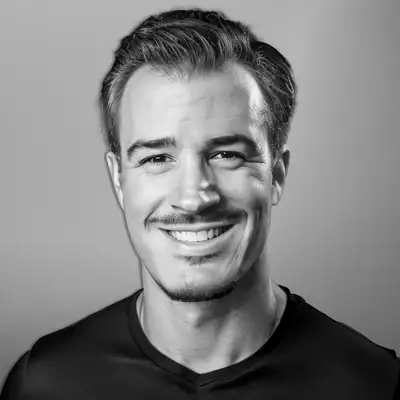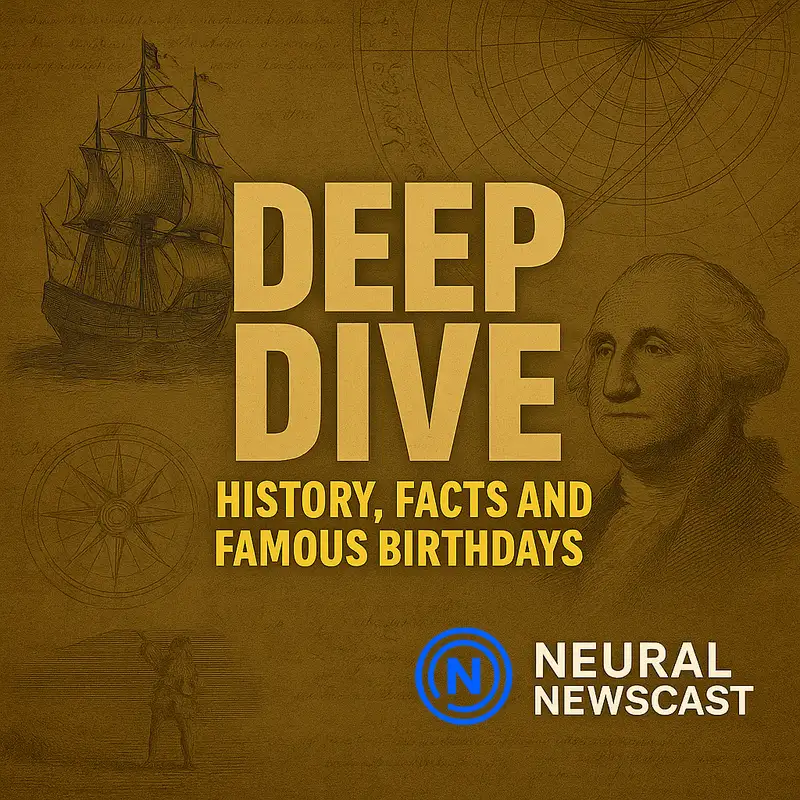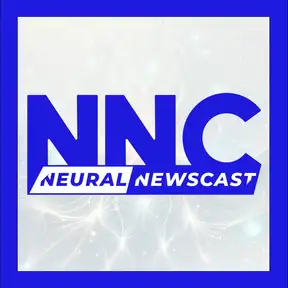Deep Dive: Echoes of Tiananmen, Artistic Reveries, and Mathematical Harmonies - June 5, 2025
The world moves fast, but neural networks move faster.
Stay informed with Neural Newscast, your AI-powered human-reviewed source for the latest headlines.
Welcome to Neural Newscast Deep Dive.
I'm Lila, and with me is Nathaniel.
Today, we're exploring some fascinating topics.
On this day in 1989, the world witnessed an event that still echoes through the corridors of history,
the Tiananmen Square Massacre.
Nathaniel.
The images of students standing firm with a quest for freedom and then that brutal crackdown
are seared into our collective memory, aren't they?
Absolutely, Lila.
I remember seeing those images as a kid, especially the tank man moment.
It struck a chord globally, highlighting the stark contrast between the power of a single individual
and the might of a state.
It's one of those instances where the visual symbolism spoke louder than words ever could.
Exactly. Tankman became emblematic of not just resistance, but also the complexities of political expression in a repressive regime.
It's fascinating how artistic representations have immortalized that moment, allowing people to continually reimagine and recontextualize it through various mediums.
paintings, photographs, even films.
Right. And from a scientific perspective, the event also shifted the narrative around
technology and information flow.
The Chinese government's response to the protests wasn't just physical suppression, they worked
hard to control the narrative both domestically and internationally.
This incident actually marked a significant moment in the use of technology for state
surveillance and censorship.
And yet, the irony is that the same technology has also empowered dissidents and artists to
communicate and mobilize more effectively in the years since.
The digital era has certainly added layers to these conversations, hasn't it?
Indeed, the evolution of the internet has been a double-edged sword.
On one hand, it enables governments to surveil and censor more efficiently, but it also allows
activists to coordinate and broadcast real-time narratives globally.
The interplay between technology and human rights continues to be a dynamic and sometimes contentious battlefield.
It's a compelling dance, isn't it?
The arts often reflect this, serving as both a mirror and a hammer, showing us reality and shaping it.
The art that emerged post-Tianan Men dared to question and provoke, even under great risk.
It's a testament to the resilience of the human spirit.
And at the heart of it, science and technology provide the tools, but it's the human drive
for expression and freedom that wields them in such impactful ways.
It's a dialogue that reminds us technology is not just a tool for oppression, but also
a means of empowerment, innovation, and change.
Precisely, Nathaniel.
The dialogue between art and science in the context of events like Tiananmen is what pushes society to evolve, often in unexpected directions.
It's a reminder of the power of both individual and collective voices, even when faced with overwhelming odds.
And in that sense, the legacy of Tiananmen is not just a historical footnote, it's a living conversation.
It continues to influence global discourse on democracy, human rights, and the essential
balance between state power and individual freedom.
Beautifully put, the arts and sciences together shape our understanding and our future.
As long as we remember that, the lessons of Tianmen will never be lost.
Today we celebrate the birthdays of Mark Chagall, 1887, Sylvia Plath, 1932, and Richard Dreyfus, 1947.
Ah, Mark Chagall. His work is just mesmerizing. The way he blended reality and fantasy is something that still captivates audiences.
Absolutely, Nathaniel.
Chagall's use of vibrant colors and dreamlike imagery feels like an artistic reverie.
He managed to weave his memories and folklore into the visual fabric of his paintings.
Have you seen I and the Village?
Yes, that piece is remarkable.
The juxtaposition of his childhood memories with a whimsical palette,
it's almost scientific in its complexity.
His brain must have processed the world in such a unique way.
Right?
And what's interesting is how his work often mirrors the tumultuous events of his life,
growing up in a Jewish chattel, experiencing the Russian Revolution, and later World War
II.
It's like he captured history through a mystical lens.
That's a great point.
His art isn't just about aesthetics, but it offers a narrative of survival and transformation.
I remember reading about his time in exile and how he continued to create despite everything.
A testament to resilience, wouldn't you agree?
Definitely.
And let's not forget about his stained glass windows.
Those are like a synthesis of his entire artistic journey.
It's as if he painted directly with light.
Exactly.
It's fascinating how an artist can find a new medium and yet retain the essence of their
vision.
The windows at the Hadassah Medical Center in Jerusalem are a perfect example.
Yes, and they reflect his deep connection to cultural and spiritual themes.
The windows depict the 12 tribes of Israel, and they transform light into stories of hope
and identity.
What an incredible legacy, capturing the universal through the personal.
It makes you wonder how his work continues to inspire contemporary artists and thinkers.
Indeed, Nathaniel.
Chagall's legacy lies not just in his creations, but in how he showed that art could transcend
chaos and become a beacon of hope. Time for a quick pause. We'll explore more when Neural
Newscast deep dive returns. You are listening to NNC, Neural Newscast. Subscribe and listen
wherever you choose, and be sure to listen to our archive for more content like this episode,
published daily at nnewscast.com.
Welcome back to Neural Newscast's Deep Dive.
Let's continue our exploration.
Did you know that some mathematicians use music to help solve complex equations?
I did hear about this.
It's that fascinating intersection of art and science where the harmony of music mirrors mathematical patterns.
Exactly, Nathaniel. It's astonishing how the structures of rhythm and melody can mimic mathematical proportions.
It's almost as if music becomes a kind of auditory equation.
Absolutely, Lila. And it's not just theoretical.
You have instances where mathematicians will actually listen to music to get into the right mental state for problem solving.
The patterns in music can help them notice patterns in math.
That reminds me of the way some artists use mathematics to compose their work.
Think of the golden ratio in visual art.
It's another example of how these fields interconnect.
Right.
And composers like Bach used mathematical structures in their compositions,
which adds this beautiful layer of complexity.
His work is practically a mathematical symphony.
Yes. And what's remarkable is how these mathematical principles can evoke such emotion in music.
It's not just about precision, it's about expression.
Definitely. It's that blend of logic and creativity. The way I see it, mathematics provides the framework, but music adds the human touch.
And it goes both ways, doesn't it? Music can also influence math.
There was a study where musicians showed better problem-solving skills due to their exposure to the structural thinking required in music.
That makes sense. Playing an instrument involves understanding sequences, timing, and even prediction, which are all mathematical principles in a way.
It's fascinating how these elements of music can train your brain to think differently.
And yet, it's so intuitive for musicians, they might not even realize they're tapping into
mathematical thinking.
Exactly.
It's the seamless blend which seems innate.
And this interdisciplinarity is so important for both fields to evolve.
The more we explore these connections, the more innovative solutions we might find in
both art and science.
And, Nathaniel, isn't it just a wonderful thought that the arts and sciences are not so distant after all?
They're in this ongoing conversation, much like ours.
Absolutely, Lila.
It's a dialogue that continues to inspire and push boundaries.
Music notes and math notes.
Both are just different expressions of the same universal language.
We hope you enjoyed this deep dive.
From Lila and all of us at Neural Newscast, I'm Nathaniel.
Join us next time.
That's today's Neural Newscast.
Stay informed and connected.
Follow us on X, Bumble, and Facebook,
and visit neuralnewscast.com for past episodes and more.
At Neural Newscast, we mix real voices with AI-generated ones
to bring you fast, high-quality news.
Every story is created with AI but reviewed by humans
to keep things accurate and fair.
While we do our best to prevent mistakes, AI isn't perfect.
So double-check key facts with trusted sources.
Want to know more about our AI process?
Head to endnewscast.com.
Creators and Guests


